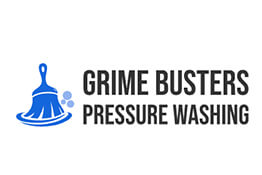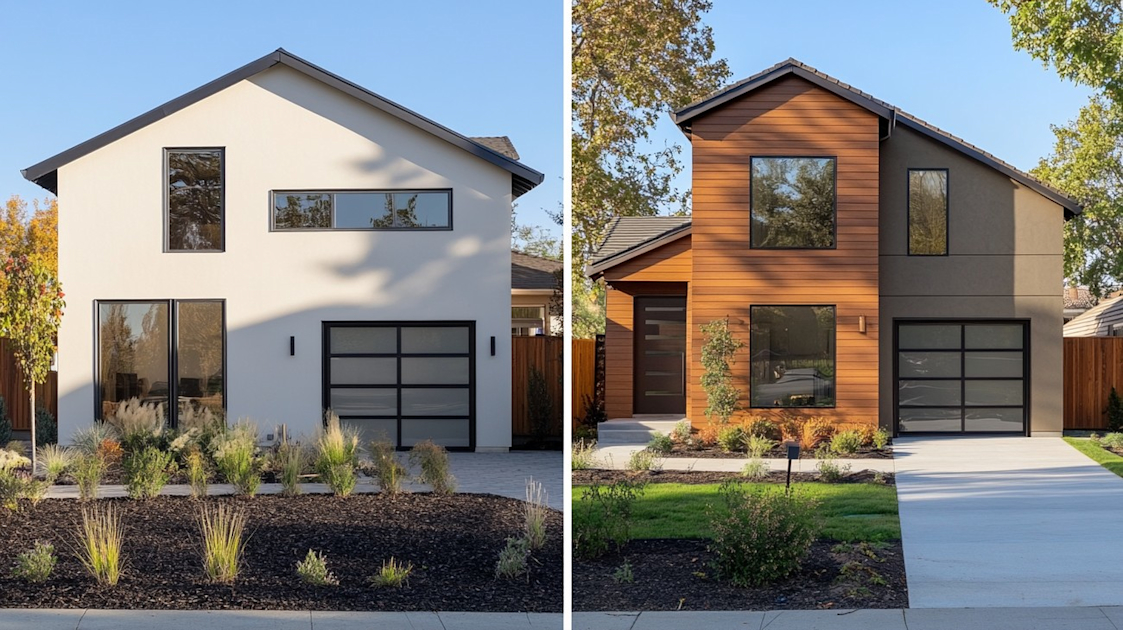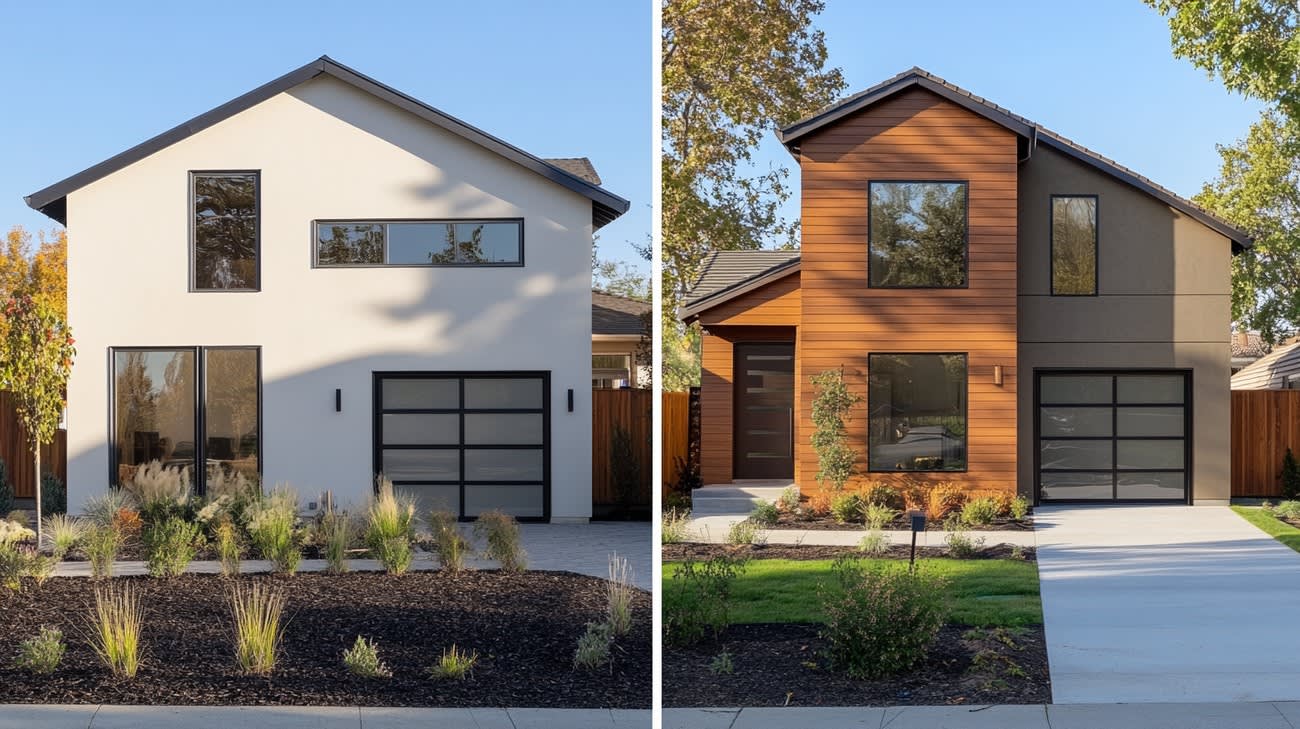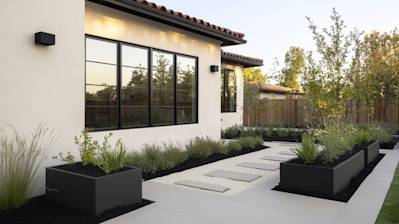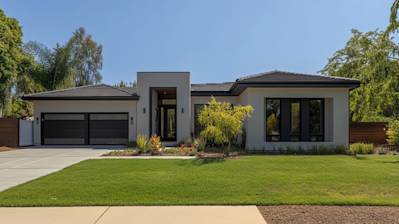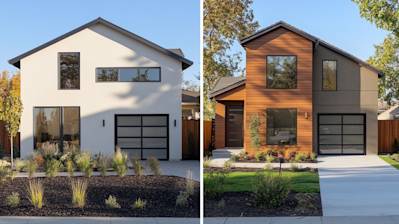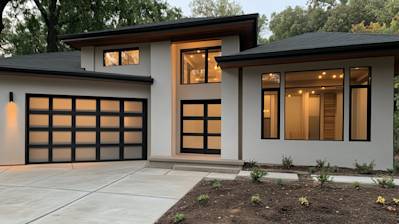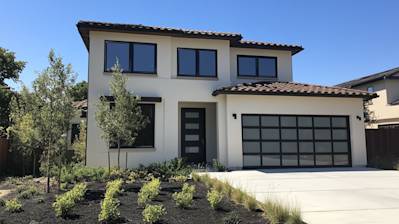Choosing the right material for your home's exterior is a big decision that requires careful consideration. In this detailed comparison between fiber cement and stucco, we will explore their composition, aesthetics, durability, maintenance, and overall cost. This rich, SEO-optimized blog post will offer homeowners valuable insights before they choose between these exterior finishes.
A Deep Dive Into The Composition of Fiber Cement and Stucco
Before deciding between fiber cement and stucco for your home's exterior, it's important to understand their make-up.
Fiber Cement Composition
Fiber cement is a composite material constructed from cement, cellulose (wood) fibers, and sand. It is known for its flexible customization options and durability against harsh climates.
Stucco Composition
Stucco is composed of sand, lime, cement, and water. It is recognized for its unique, textured appearance and its capacity to handle hot climates efficiently.
Comparing the Aesthetic Appeal of Fiber Cement and Stucco
The aesthetics of your home's exterior significantly influences its curb appeal, and the material you choose can make a big difference.
The Look of Fiber Cement
Fiber cement siding is versatile and can be manufactured to imitate a range of materials, including wood, brick, and stone. It can also be painted in any color to match your home's style. Many homeowners appreciate this customization capability for creating distinctive looks.
The Texture of Stucco
Stucco displays a unique, textured finish that is hard to replicate with other materials. It can be manipulated to create a variety of appealing patterns, giving homes a Mediterranean, Spanish, or Tuscan look. However, its color options are relatively limited as compared to fiber cement.
Fiber Cement Vs Stucco: Durability and Maintenance
Fiber Cement: Strong and Weather-Resistant
Fiber cement is renowned for its longevity and resistance against harsh weather conditions, including:
- Heat
- Humidity
- Rain
- Wind
- Fire
Furthermore, it's resistant to insects and rodents, and it doesn't rot. However, while fiber cement is long-lasting, it requires periodic painting and maintenance.
Stucco: Hardy and Heat-Tolerant
Stucco is praised for its incredible hardiness and heat tolerance. It's resistant to fire, but unlike fiber cement, it can chip and crack over time. Regular check-ups are hence required to maintain its aesthetic appeal.
While stucco does not require regular repainting like fiber cement, it can be fairly complex to fix or replace when damaged, making maintenance a bit challenging.
Cost Implication: Fiber Cement vs Stucco
Fiber cement and stucco have different cost implications that need to be considered.
The Cost of Fiber Cement
Fiber cement siding is an affordable option with a moderate installation cost. Priced between $6 to $12 per square foot, fiber cement is less expensive than stucco. However, repainting every 10-15 years can add to the expense.
The Cost of Stucco
Stucco's installation cost is slightly more expensive than fiber cement, averaging between $8 to $14 per square foot. But with minimal painting requirements and long-lasting nature, stucco could provide significant savings over time.
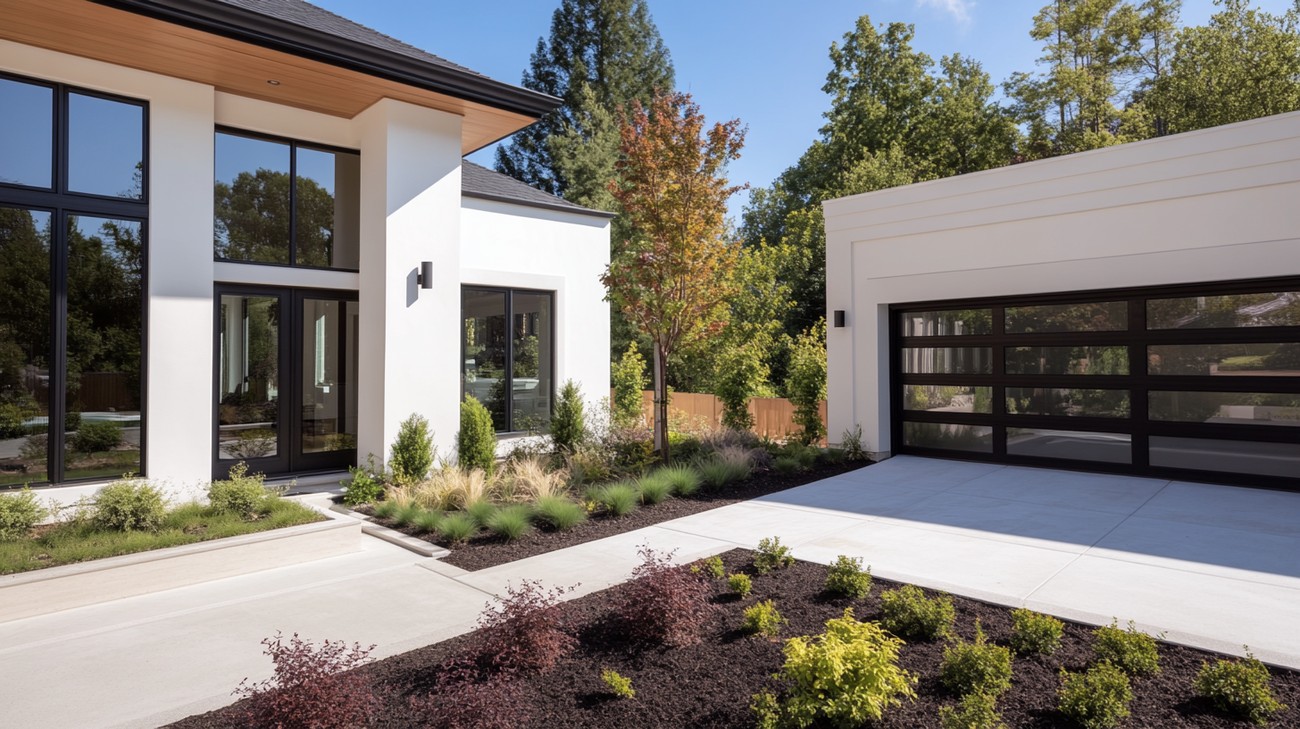
Frequently Asked Questions about Fiber Cement Vs Stucco
What is Stucco?
On the other hand, stucco is a type of plaster made from cement, lime, and sand. It's traditionally been used in Spanish and Mediterranean architecture but is versatile enough to fit many home styles. Stucco is appreciated for its durability, weather resistance, and unique, textured appearance.
What are the Differences in Installation Between Fiber Cement and Stucco?
Installation is where you'll notice a significant difference between fiber cement and stucco. Fiber cement is easier to install than stucco, which requires expert plastering skills to ensure a successful application. Due to its weight, fiber cement also requires less structural support than stucco, and it comes in panels that interlock or overlap, making installation quicker.
How Does Climate Affect the Choice Between Fiber Cement and Stucco?
All exterior materials are affected by the climate, and both fiber cement and stucco are no exception. While fiber cement performs well in varying climates, it tends to fare better in damp climates than stucco, which can absorb moisture and potentially cause structural damage. Stucco, however, excels in hot, dry climates where it helps keep homes cool.
Which is More Cost-Effective: Fiber Cement or Stucco?
When considering cost, fiber cement generally comes out on top as the less expensive option. While the actual cost can vary, fiber cement is typically cheaper to buy and install than stucco due to its simpler installation process. However, both options are considered long-lasting and can save you money in long-term maintenance costs.
Which Offers More Design Flexibility: Fiber Cement or Stucco?
In terms of design flexibility, fiber cement provides more options. It can be easily painted in any color and is available in a wide range of textures and profiles. While stucco can also be painted, its texture is harder to alter once it is applied, making fiber cement a more flexible choice for homeowners craving diverse design possibilities.
How do Fiber Cement and Stucco Compare in Terms of Maintenance?
Comparing maintenance demands, fiber cement needs less frequent attention than stucco. Fiber cement requires a new coat of paint approximately every 5-7 years, while stucco may require repainting and sealing more often to prevent moisture absorption. However, it's worth noting that with both materials, regular inspections for damage and potential problems are encouraged.
How does the Longevity of Fiber Cement and Stucco Compare?
Both fiber cement and stucco are renowned for their longevity and can offer decades of performance. Fiber cement can last 50 years or more with proper maintenance, while stucco, when kept in good condition, can last up to 80 years. It's a close call, but stucco may edge out fiber cement in terms of pure lifespan.

Pros of Fiber Cement
Durability
Fiber cement is immensely durable. It is resistant to the common problems that plague other materials like rot, fungus, and pests. This is because, unlike wood, it doesn't retain moisture. This also makes it an excellent choice for climates subject to lots of rain or snow.
Fire Resistance
Fiber cement is a fire resistant material. This makes it a great choice for fire-prone areas. The material is non-combustible and achieves the highest possible rating (A1) on the European fire resistance classification.
Maintenance
Fiber cement is low-maintenance. It doesn't require regular repainting or staining — most manufacturers offer products with a baked-on color finish that lasts for years.
Environmentally Friendly
Fiber cement is often made from sustainable materials, making it a more environmentally-friendly choice. Also, because it lasts such a long period, it reduces the need for replacement and reduces waste.
Cons of Fiber Cement
Installation Cost
While fiber cement might be a low maintenance material, its initial installation cost can be higher than that of traditional materials like stucco.
Installation Difficulty
Installing fiber cement can be a rigorous process. The boards are often heavy, requiring special handling and tools. Also, because of fiber cement's durability and hardness, it can be challenging to cut.
Appearance
Though fiber cement can mimic the look of wood and other materials, it doesn't exactly match. Purists might not like the look of fiber cement siding that's designed to resemble other materials.
Pros of Stucco
Durability
Stucco walls are incredibly durable, with a life expectancy of up to 100 years. This can be longer if the building is well maintained.
Resistance
Stucco is fire resistant as well. It also resists mold and mildew, making it a good choice for damp conditions or climates with high humidity.
Aesthetic Appeal
Stucco adds to the aesthetic appeal of any building structure. As a versatile material, it can be easily colored and shaped to give a unique look to the building.
Energy Efficiency
Stucco helps with thermal insulation, keeping the building cooler in the summer and warmer in winter. This can be a key factor in energy efficiency.
Cons of Stucco
Cost
Stucco, in general, is more expensive than other siding options. The installation process can also be expensive since it requires skilled labor and several layers for proper application.
Prone to Cracks
One of the major drawbacks of stucco is that it is prone to cracks. Although minor cracks can be easily repaired, larger ones can compromise the integrity of the wall and lead to more significant issues.
Limited Choices
With stucco, there are limitations on color choices and textures compared to other siding options. Over time, the color might fade and require repainting.
Not Suitable for Every Climate
While stucco is a versatile material, it may not be the best choice for all climates. In areas of extreme cold or where there's a lot of rainfall, stucco can absorb water, resulting in potential damage.

Myths and Misconceptions about Fiber Cement and Stucco
When debating the merits of fiber cement versus stucco, misunderstandings often fuel the discussion. These misconceptions can significantly influence homeowners' decisions about which material they should choose for home renovation or construction projects. This section aims to dispel such myths to provide accurate and reliable information about these two materials.
Myth 1: Fiber Cement Is Always the Best Option
Myth Complexity
Often, homeowners automatically assume that fiber cement is the superior material. However, both fiber cement and stucco have their strengths and weaknesses. Each can be the "best choice" depending on the individual needs of a specific project.
Reality Check
The geographic location, the climate, the architectural style of the house, and the property owner’s preferences are important factors to consider when choosing between these two materials. In areas with warm, humid climates, stucco tends to perform better than fiber cement. On the other hand, fiber cement can be an excellent choice for homes in regions with harsh, variable weather conditions due to its superior resistance to elements.
Myth 2: Stucco Is Prone to Cracking
Myth Complexity
Stucco has an unfortunate reputation for cracking easily. While it's true that inappropriate installation or inconsistent weather conditions might lead to damage, it doesn't mean that stucco is inherently flawed or inferior in quality.
Reality Check
Like any material, stucco requires proper installation and maintenance to maximize its potential. If the right installation methods are applied and the stucco is well-maintained, it can resist cracking effectively and offers a durable, long-lasting exterior for homes.
Myth 3: Fiber Cement Requires No Maintenance
Myth Complexity
Contrary to the common myth, fiber cement isn't maintenance-free. Although fiber cement siding is more durable and has a longer lifespan compared to other materials, it still requires periodic attention.
Reality Check
Fiber cement is susceptible to damage from impact, moisture, and prolonged exposure to the elements, although to a lesser extent than other siding options. Regular cleaning, repainting, and occasional repair are essential to keep its appearance and integrity intact.
Myth 4: Only Stucco Works for Spanish Style or Mediterranean Homes
Myth Complexity
This myth originated from its extensive use in these types of houses. While it’s true that stucco is commonly associated with Spanish-style and Mediterranean houses because of the aesthetic it produces, it’s not the only choice.
Reality Check
Fiber cement can mimic the look of various other materials, including stucco, using different texturing techniques. By choosing the right texture, homeowners can achieve the desired Mediterranean or Spanish style look using fiber cement.
Myth 5: Fiber Cement Poses Health Risks
Myth Complexity
There's a persistent myth that fiber cement siding can release harmful silica dust into the air, posing health risks to the homeowner and their family.
Reality Check
While silicosis is a known threat to workers who cut or sand fiber cement boards without adequate protection, once the fiber cement boards are securely installed, they pose minimal to no health risks. Both the cutting and installation processes should be done in a well-ventilated area using appropriate personal protective equipment.
Myth 6: Stucco Cannot Be Painted
Myth Complexity
Some believe that stucco cannot be painted, limiting its adaptability to different color schemes and styles.
Reality Check
Stucco can indeed be painted, and with the right type of paint, the overall longevity of the stucco can actually be enhanced. The key lies in choosing paints that allow the stucco to breathe and avoid trapping moisture which might lead to damage over time.
In conclusion, myths and misconceptions about fiber cement and stucco are quite widespread. However, understanding the nuances and facts related to these materials can assist homeowners and builders in making the best decisions for their specific needs and circumstances.
Summary
Overall, when we're discussing "fiber cement vs stucco", the outcome really comes down to the specific needs of the homeowner. Both materials have their own unique set of benefits. Fiber cement is a bit more versatile and easier to maintain. It’s resistant to rot and insects, and performs better in regions with volatile weather. That said, it doesn’t have quite the old-world charm that stucco does.
Stucco, on the other hand, really shines in dry climates, and offers that classic Southwestern look and feel. It is highly durable but can be prone to cracking in areas with high moisture or lots of freeze-thaw cycles. In addition, stucco may need to be repainted more frequently than fiber cement. Though it requires more upkeep, many homeowners feel the aesthetic appeal of stucco is well worth it.
So, whether you choose fiber cement or stucco depends on your geographic location, your personal preference in terms of aesthetics, and how much maintenance you're comfortable handling. Both are proven options that can add to the personality and longevity of your home. Just make sure to consider all the factors before you make a final choice.
About Atlas Stucco
Atlas Stucco is your friendly neighborhood stucco provider located in sunny Sacramento, CA. We're known for our love of all things stucco, and we're passionate about bringing our clients' visions to life using this versatile material. We’ve been in the industry for decades, easily smashing through complexities, and establishing ourselves as leaders in our field. When it comes to giving buildings a facelift that not only looks great but also stands up against time, you can trust us to deliver each time. So, if you live in Sacramento, we're your go-to stucco guys!
Tags: fiber cement, stucco, comparison,
